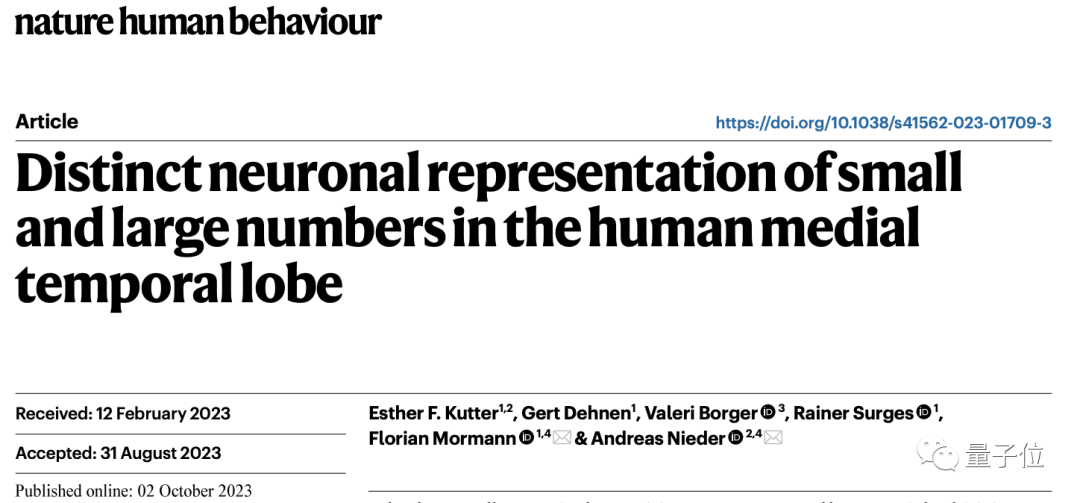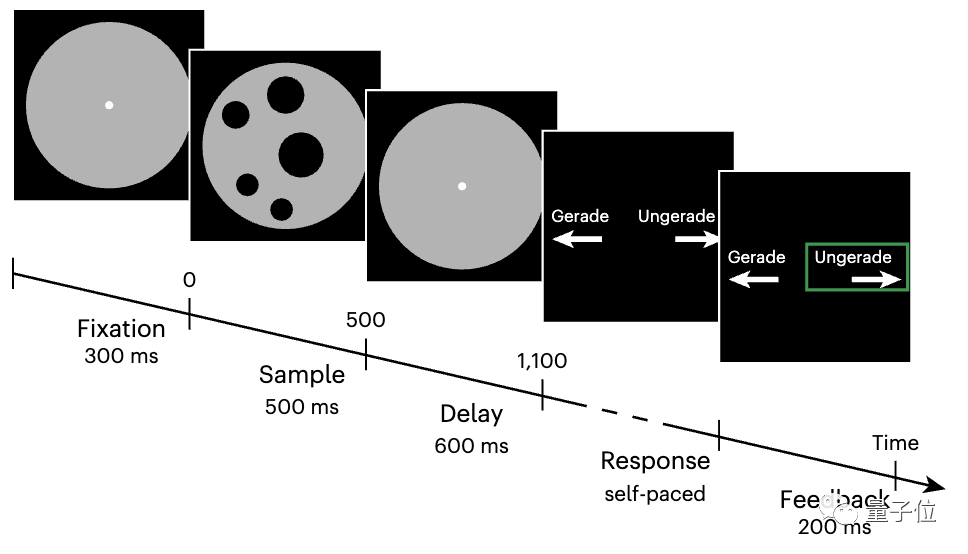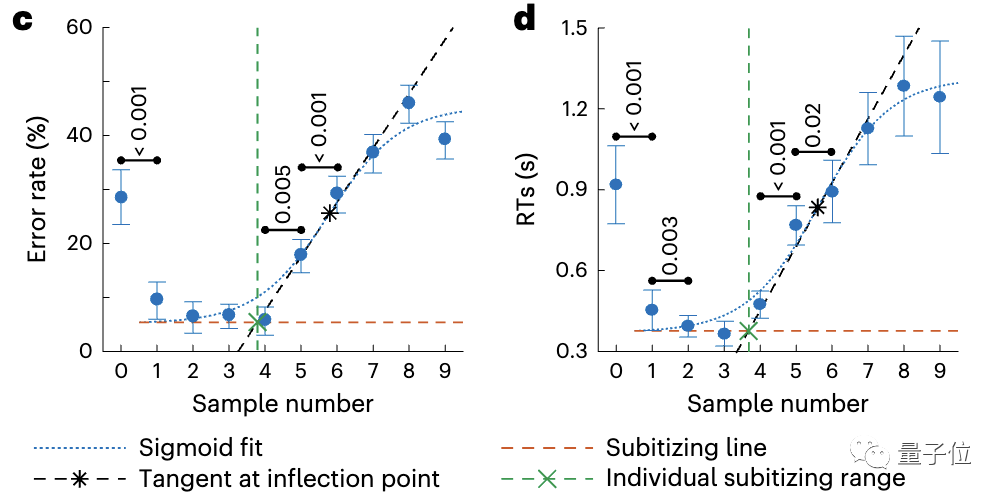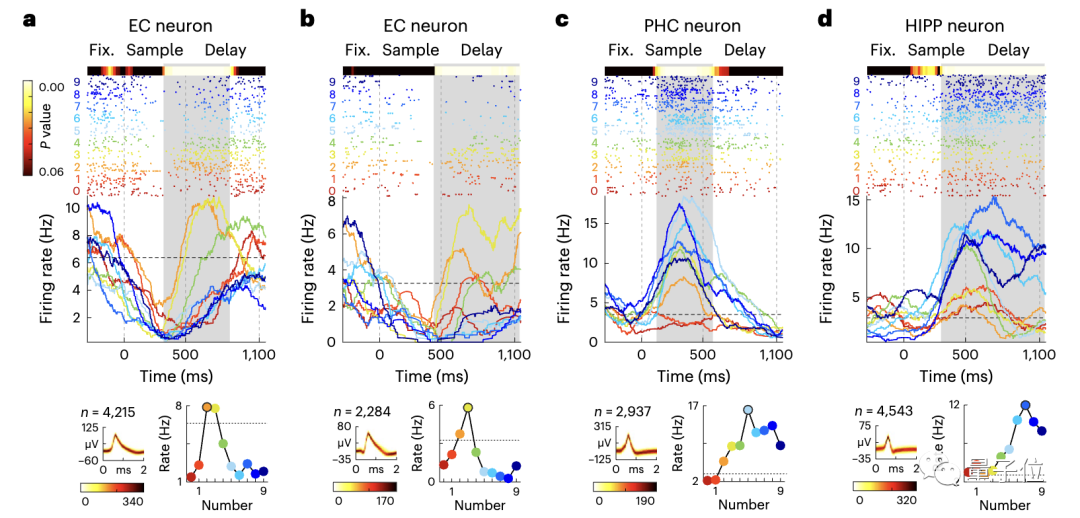 Technology peripherals
Technology peripherals
 AI
AI
 The human brain has cognition of the number '4', but not the number '5'! Scientific evidence supports that the four heavenly kings F4 are all '4' (doge)|Nature
The human brain has cognition of the number '4', but not the number '5'! Scientific evidence supports that the four heavenly kings F4 are all '4' (doge)|Nature
The human brain has cognition of the number '4', but not the number '5'! Scientific evidence supports that the four heavenly kings F4 are all '4' (doge)|Nature
Please answer within half a second. How many apples are there in the picture below:

Do you know at a glance that there are four on the left, and... many on the right? Why can't we instantly determine which one is on the right?
In addition to this phenomenon, there are some similar examples, such as the "Four" Great Heavenly Kings, F "4", "Four" Xiao Hua Dan, etc. Why does this all have to do with the number "4"?
Nature's latest report provides a direct basis to explain this phenomenon - The brain recognizes "4" but not "5".
Researchers from the University Medical Center of Bonn, Germany, observed the activity of single neurons and found that the brain uses a different system to recognize the number "1-4" and to recognize the number "5-9",The boundary is "4".
Specifically, when neurons process the number 1-4, specific neurons are used; while when processing 5-9, the response is not specific and will be interfered by adjacent numbers.
For example: a neuron that prefers the number 3 will only respond to 3, while a neuron that prefers the number 8 will respond to 8, but also to the numbers 7 and 9
This discovery is of great significance to understanding the nature of human thinking. Lisa Feigenson, a psychologist at Johns Hopkins University, said:
Fundamentally, the question involves the structure of the mind: What forms the basis of the human mind?
The human brain recognizes "4" but not "5"
In an article published in "Nature" magazine in 1871, economist and logician William ·Stanley Jevons investigated the human counting ability and came to the following conclusion:
Some people are unable to judge the size of the number "5"
Some people are unable to judge the size of the number "5"
Researchers subsequently analyzed that this was due to the brain using only one counting system, which is less accurate for larger numbers. Others hypothesized that the difference stems from the fact that there are two independent neural systems. The system was used to count and then further studied using techniques such as electroencephalography and functional magnetic resonance imaging, but the results were inconsistent and it was impossible to determine which model was correct.
Until recently, a research team from the University of Bonn in Germany used new technology to record the activity of single neurons in the human brain, and finally discovered the difference in neural coding between small numbers and large numbers.

Specifically, the data were obtained from 17 epilepsy patients. In order to help doctors find the source of epilepsy, these patients underwent invasive medical monitoring, that is, microelectrodes were implanted in the brain
While the patients underwent monitoring surgery, the microelectrodes recorded801 The activity of a single neuron. These neurons come from four areas of the brain: the amygdala, hippocampus, ventromedial temporal lobe, and ventrolateral temporal lobe.
During the recording process, the patient needs to do a quantity judgment task:
The screen will display non-symbolized "dot matrix" images in the range of 0-9, and each image will last half a second. . Participants need to press the left and right keys to indicate whether the number on the image is even or odd.

The dot matrix is presented in standard format and control format. The following are three dot matrix arrangements. :
△ (Left) Standard layout, the size and position of points are variable; (Middle) Control layout, the total area and density of points are balanced; (Right) Points are linear Arrangement
In the behavioral test, the patient's judgment of small quantities was significantly more accurate, and the reaction time was shorter, showing "subization" characteristics.
(Saturation, a term in psychology and cognitive science, refers to the human ability to quickly estimate small quantities of items.)
When After the quantity is greater than 4, the judgment slows down and the error rate increases, reflecting the "quantity estimation" process.
The researchers calculated the error rate and reaction time respectively, and finally determined that the upper limit of the subization range was on average 3.7 (error rate) and 3.6 (reaction time).

The analysis of neuronal responses further confirmed the accuracy of the behavioral results
Decimal digitization system & large number estimation system
In a single neuron At the meta-level, the researchers also observed similar coding patterns
They found neurons that selectively responded to non-symbolized quantities in the four recording brain areas, and these selective neurons covered 0 -9 complete quantity range.
The proportion of selective neurons in different brain regions is around 15.1%, which is significantly higher than random levels.
After analyzing the neuron tuning curve characteristics and correlations, the researchers found:
For small numbers 1-4, the neurons are highly selective for the preferred number and inhibit the non-preferred number Quantitative response, thus improving the recognition effect.
For a neuron that is sensitive to changes in quantity, it will produce the maximum response to a specific quantity. The quantity that causes the maximum response is the "preferred quantity" of the neuron
When the number is greater than 4, the tuning curve of the neuron becomes wider and the selectivity decreases, and returns to the baseline level as the number increases, which is consistent with the characteristics of number estimation

The researchers then further used SVM to decode selective neurons, conduct state space analysis and clustering analysis, and conduct statistics on neuron groups The test also found that there is a classification boundary for quantity judgment, and the most significant difference is between quantities 4 and 5.
This boundary is very consistent with human intuitive judgment
This study provides direct evidence that a system of "subitization" of small numbers and a system of "estimation" of large numbers can coexist
The "subized" system may be related to attention and working memory, which explains our sharp judgment on small amounts of information, while the brain needs to rely on slower and systematic information processing for input that exceeds capacity.
However, the researchers also mentioned that the more complex network mechanisms need to be further explored, such as whether there are similar coding differences in other brain areas and whether this phenomenon can also be observed in more complex cognitive tasks. Temporal effects of inhibitory loops, etc.
Paper link: https://www.nature.com/articles/d41586-023-03136-w
The above is the detailed content of The human brain has cognition of the number '4', but not the number '5'! Scientific evidence supports that the four heavenly kings F4 are all '4' (doge)|Nature. For more information, please follow other related articles on the PHP Chinese website!

Hot AI Tools

Undresser.AI Undress
AI-powered app for creating realistic nude photos

AI Clothes Remover
Online AI tool for removing clothes from photos.

Undress AI Tool
Undress images for free

Clothoff.io
AI clothes remover

Video Face Swap
Swap faces in any video effortlessly with our completely free AI face swap tool!

Hot Article

Hot Tools

Notepad++7.3.1
Easy-to-use and free code editor

SublimeText3 Chinese version
Chinese version, very easy to use

Zend Studio 13.0.1
Powerful PHP integrated development environment

Dreamweaver CS6
Visual web development tools

SublimeText3 Mac version
God-level code editing software (SublimeText3)

Hot Topics
 Bitcoin price today
Apr 28, 2025 pm 07:39 PM
Bitcoin price today
Apr 28, 2025 pm 07:39 PM
Bitcoin’s price fluctuations today are affected by many factors such as macroeconomics, policies, and market sentiment. Investors need to pay attention to technical and fundamental analysis to make informed decisions.
 What are the top ten virtual currency trading apps? The latest digital currency exchange rankings
Apr 28, 2025 pm 08:03 PM
What are the top ten virtual currency trading apps? The latest digital currency exchange rankings
Apr 28, 2025 pm 08:03 PM
The top ten digital currency exchanges such as Binance, OKX, gate.io have improved their systems, efficient diversified transactions and strict security measures.
 Decryption Gate.io Strategy Upgrade: How to Redefine Crypto Asset Management in MeMebox 2.0?
Apr 28, 2025 pm 03:33 PM
Decryption Gate.io Strategy Upgrade: How to Redefine Crypto Asset Management in MeMebox 2.0?
Apr 28, 2025 pm 03:33 PM
MeMebox 2.0 redefines crypto asset management through innovative architecture and performance breakthroughs. 1) It solves three major pain points: asset silos, income decay and paradox of security and convenience. 2) Through intelligent asset hubs, dynamic risk management and return enhancement engines, cross-chain transfer speed, average yield rate and security incident response speed are improved. 3) Provide users with asset visualization, policy automation and governance integration, realizing user value reconstruction. 4) Through ecological collaboration and compliance innovation, the overall effectiveness of the platform has been enhanced. 5) In the future, smart contract insurance pools, forecast market integration and AI-driven asset allocation will be launched to continue to lead the development of the industry.
 Which of the top ten currency trading platforms in the world are the latest version of the top ten currency trading platforms
Apr 28, 2025 pm 08:09 PM
Which of the top ten currency trading platforms in the world are the latest version of the top ten currency trading platforms
Apr 28, 2025 pm 08:09 PM
The top ten cryptocurrency trading platforms in the world include Binance, OKX, Gate.io, Coinbase, Kraken, Huobi Global, Bitfinex, Bittrex, KuCoin and Poloniex, all of which provide a variety of trading methods and powerful security measures.
 How to use the chrono library in C?
Apr 28, 2025 pm 10:18 PM
How to use the chrono library in C?
Apr 28, 2025 pm 10:18 PM
Using the chrono library in C can allow you to control time and time intervals more accurately. Let's explore the charm of this library. C's chrono library is part of the standard library, which provides a modern way to deal with time and time intervals. For programmers who have suffered from time.h and ctime, chrono is undoubtedly a boon. It not only improves the readability and maintainability of the code, but also provides higher accuracy and flexibility. Let's start with the basics. The chrono library mainly includes the following key components: std::chrono::system_clock: represents the system clock, used to obtain the current time. std::chron
 How much is Bitcoin worth
Apr 28, 2025 pm 07:42 PM
How much is Bitcoin worth
Apr 28, 2025 pm 07:42 PM
Bitcoin’s price ranges from $20,000 to $30,000. 1. Bitcoin’s price has fluctuated dramatically since 2009, reaching nearly $20,000 in 2017 and nearly $60,000 in 2021. 2. Prices are affected by factors such as market demand, supply, and macroeconomic environment. 3. Get real-time prices through exchanges, mobile apps and websites. 4. Bitcoin price is highly volatile, driven by market sentiment and external factors. 5. It has a certain relationship with traditional financial markets and is affected by global stock markets, the strength of the US dollar, etc. 6. The long-term trend is bullish, but risks need to be assessed with caution.
 Recommended reliable digital currency trading platforms. Top 10 digital currency exchanges in the world. 2025
Apr 28, 2025 pm 04:30 PM
Recommended reliable digital currency trading platforms. Top 10 digital currency exchanges in the world. 2025
Apr 28, 2025 pm 04:30 PM
Recommended reliable digital currency trading platforms: 1. OKX, 2. Binance, 3. Coinbase, 4. Kraken, 5. Huobi, 6. KuCoin, 7. Bitfinex, 8. Gemini, 9. Bitstamp, 10. Poloniex, these platforms are known for their security, user experience and diverse functions, suitable for users at different levels of digital currency transactions
 Which of the top ten currency trading platforms in the world are among the top ten currency trading platforms in 2025
Apr 28, 2025 pm 08:12 PM
Which of the top ten currency trading platforms in the world are among the top ten currency trading platforms in 2025
Apr 28, 2025 pm 08:12 PM
The top ten cryptocurrency exchanges in the world in 2025 include Binance, OKX, Gate.io, Coinbase, Kraken, Huobi, Bitfinex, KuCoin, Bittrex and Poloniex, all of which are known for their high trading volume and security.






